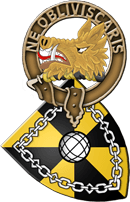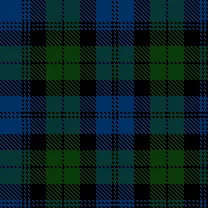There are many tartans which have, in one way or another, been associated with the Campbell name. Ever since Clan Tartans became recognized as such, the authority as to which tartan is authorized for a clan has been vested by courtesy and custom in the clan Chief.
Always remember that those who sell tartan have one objective, to sell. If those in the trade make use of the concept of "clan tartans" entirely as a gimmick to sell more tartan one cannot be surprised if, having used the idea of clan tartans to get you into their store, they then fail to inform you of which tartans are authorized by the chiefs once they are pressing upon you what they have available in stock.
WHICH ARE AUTHENTIC CAMPBELL TARTANS
INTRODUCTION
Few sellers of tartan have ever bothered to find out which tartans the chief's have authorized because the whole idea is anathema to them. They are naturally disturbed at a concept which places some of the control of what they sell into the hands of others. Never put your trust in the salesperson for advice on issues of tartan. Know what you need before you enter the store or take an illustration with you showing what you want.
This does not mean that you should be unfriendly or discourteous to those in the trade, most are fine people. Simply chose to ignore any expertise on clan tartan issues just as they have chosen to ignore the chiefs. On other issues, such as weight of cloth, style of jacket, yards in a kilt or availability of material, they are frequently well worth consulting.
The members of the trade are perfectly within their rights to act as they do, although one suspects that in time by their duplicity and lack of courtesy to the chiefs they may end up cutting their own throats. They are within their rights because there are not and never have been any laws about which tartan anyone wears. Only customs of courtesy about not wearing the tartan of another clan but wearing what was authorized by your own chief have kept the idea of clan tartans alive. Without that authority, the whole concept of clan tartans makes no sense.
This very lack of rules and the reliance upon courtesy is a very strong element in Highland culture. While frustrating to the North American training to force everything into clear-cut guidelines, it is a very large part of the charm of tartan today.
A MATTER OF CUSTOM
The idea of clan tartans has influenced Highlanders for 170 years, long enough to be considered a valid tradition even in Scotland.
Before looking into the options when buying tartan, some words written by Alastair Lorne Campbell of Airds, former Chief Executive of Clan Campbell in his book "Campbell Tartan" are very much worth absorbing:
"... what early portraits there are showing tartan would strongly support the view that, while tartan itself is of early date, until comparatively recently what pattern was worn depended, not on any `Clan' significance, but on what was available locally and what took the wearer's fancy."
"The whole idea of uniformity in tartan most probably had a military origin. There is evidence to suggest that, as early as 1725, the Independent Highland Companies may all have been clothed in the same sett. Indeed it is impossible to overstate the influence of the military on the survival and the development of tartan and indeed all Highland dress as we know it today."
"The performance of the Highland regiments had much to do with raising popular esteem for the Highlanders in general, and towards the end of the 18th century, a wave of romanticism built up which reached a peak in 1822 with the Royal Visit to Edinburgh of King George IV. It was a few years prior to this, in 1816, that the Highland Society of London, which had organized the campaign for the repeal of the Act of Proscription, put together a collection of tartans, signed and sealed by the Chiefs concerned as being that of their Clans. Contemporary correspondence reveals that in many cases the Chiefs had no idea what their tartan should be - hardly surprising in the circumstances - but as always the tartan manufacturers had no difficulty in providing something suitable."
"The idea of a Clan tartan is a very attractive one, and it found ready acceptance. During the 19th century examples proliferated and they have continued to do so, receiving, as is only to be expected, every encouragement from the manufacturers ..."
In his introduction to 'Campbell Tartan', our Chief, Mac Cailein Mor, Ian Campbell, 12th Duke of Argyll, states "The prerogative is the Clan Chief's alone, and that of nobody else, to state what are the clan tartans ..." It is not that of the Lord Lyon King of Arms, Scotland's official heraldic authority, nor is it that of the Scottish Tartan Society or of their fine Museum.
A QUESTION OF STYLE
The size of the pattern or sett of tartan is derived from the `thread count'. This means that the scale of pattern using thick thread (i.e., heavy wool thread) will be large, whereas that using thin thread (such as silk) will be smaller. The proportion does not change the designation of the tartan provided that the thread count is correct for that sett. Pattern size can also be enlarged by multiplying the thread count proportionately.
Some families in Argyll have a tradition of using the darker `Black Watch' tartan for an evening kilt and the brighter colors for day wear.
When buying Campbell tartan, called 'Ancient Campbell' in the trade, you may be shown 'faded' or 'muted' colors. These are perfectly legitimate where the black, green and blue are recognizable as such.
For a time earlier in this century there was talk of "vegetable dyes" as opposed to "industrial dyes" and this was used to differentiate between the lighter colors of the Campbell (now called "ancient" in the trade) and the darker Black Watch colors. The term, however, no longer applies to modern techniques and so has gone out of use. For further information read 'Campbell Tartan' 1985, by Alastair Lorne Campbell of Airds, available from a number of specialty booksellers handling books on Scottish subjects .


